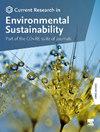A comprehensive analysis of resource conservation strategies: Impacts on productivity, energetics, and environmental footprints in rice-based systems of the Eastern Indo-Gangetic Plains
IF 3.7
Q2 ENVIRONMENTAL SCIENCES
Current Research in Environmental Sustainability
Pub Date : 2024-01-01
DOI:10.1016/j.crsust.2024.100271
引用次数: 0
Abstract
In Eastern Indo-Gangetic Plains, traditional rice-wheat cropping system, reliant on wet puddling for rice and conventional tillage for wheat, has led to the soil degradation and stagnant yields, highlighting the need for sustainable practices. A field experiment (2018–2021) evaluated the impacts of tillage and residue management on productivity, energy efficiency, and soil health across three cropping systems: rice-wheat (RW), rice-maize (RM), and rice-chickpea (RC). Three tillage practices-conventional tillage (CT), reduced tillage (RT), and reduced tillage with 30 % residue retention (RTR30) were arranged in a randomized block design. The results showed that partial conservation agriculture (pCA) practices significantly enhanced the system productivity, with RM under RT achieving the highest yield (12.2 Mg ha−1). Reduced tillage consistently the minimized energy use, while pulses-based systems had the highest energy ratio (3.97). On average, total earthworm counts were 0.92 and 6.5 times higher during the rainy and post-rainy seasons in pCA treatments in comparison to CT. Earthworm species diversity was more in pCA-based production systems (RT/RTR30) than in CT. In rice-wheat cropping system, maximum bacterial and actinomycetes counts were observed in CT/FP followed by pCA production system. Maize-based systems under CT had the highest global warming potential, while the pulse-based systems had the lowest. The RM cropping system under RTR30 demonstrated the greatest increase in the soil organic carbon. In conclusion, adopting pCA management practices and incorporating the pulses can improve crop productivity, soil health, and sustainability, offering a promising path for enhancing food and nutritional security in rice-based production systems.

资源保护策略的综合分析:对印度-恒河平原东部水稻系统生产力、能量学和环境足迹的影响
在印度-恒河平原东部,传统的水稻-小麦种植系统依赖于水稻的湿耕和小麦的传统耕作,导致土壤退化和产量停滞,突出了可持续做法的必要性。一项田间试验(2018-2021)评估了耕作和残留物管理对水稻-小麦(RW)、水稻-玉米(RM)和水稻-鹰嘴豆(RC)三种种植制度的生产力、能源效率和土壤健康的影响。采用随机区组设计,将常规耕作(CT)、减少耕作(RT)和减少耕作(RTR30)三种耕作方式进行分组。结果表明,部分保护性农业(pCA)显著提高了系统生产力,其中部分保护性农业(pCA)的产量最高(12.2 Mg ha−1)。减少耕作的能量消耗始终最小,而基于脉冲的系统的能量比最高(3.97)。在雨季和雨季后,与CT相比,pCA处理的蚯蚓总数平均高出0.92倍和6.5倍。基于pca的生产系统(RT/RTR30)中蚯蚓物种多样性高于CT。在稻麦种植体系中,细菌和放线菌数量最多的是CT/FP种植体系,其次是pCA生产体系。基于CT的玉米系统的全球变暖潜势最高,而基于脉冲的系统的全球变暖潜势最低。RTR30下RM种植制度土壤有机碳增加幅度最大。综上所述,采用pCA管理实践并结合豆类可以提高作物生产力、土壤健康和可持续性,为加强水稻生产系统的粮食和营养安全提供了一条有希望的途径。
本文章由计算机程序翻译,如有差异,请以英文原文为准。
求助全文
约1分钟内获得全文
求助全文
来源期刊

Current Research in Environmental Sustainability
Environmental Science-General Environmental Science
CiteScore
7.50
自引率
9.10%
发文量
76
审稿时长
95 days
 求助内容:
求助内容: 应助结果提醒方式:
应助结果提醒方式:


